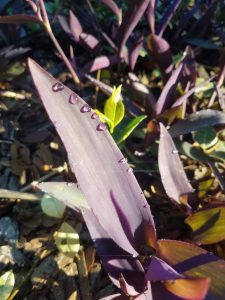Many of us know bees are susceptible to direct exposure to pesticides. But there are other ways bees are exposed to pesticides indirectly. Guttation is the process whereby plants emit sap or liquid from the edges or tips of leaves. One example of a plant that shows guttation is the purple-leaved groundcover purple queen Setcreasea pallida https://edis.ifas.ufl.edu/publication/FP549.
Recently, I noticed the purple queen plants in my garden in early morning. I could see liquid drops evenly spaced on the leaf edges. Bees visited the plants, collecting nectar and pollen. The three-petalled, pink-flowers are a bee favorite.
Since bees also drink water, it’s important to recognize that plants – such as purple queen – could expose bees to pesticides and other compounds when bees encounter liquids secreted by plants through guttation. Bees and other pollinators can be exposed to pesticide residues in wood, soil, guttation drops, leaves, water, pollen, and nectar (Sanchez-Bayo and Goka, 2016).
Next time you’re in the garden, see if you can find a plant that shows guttation. Be careful when using pesticides in the garden, especially around plants like these, to minimize exposure of bees and other pollinators.
 0
0

